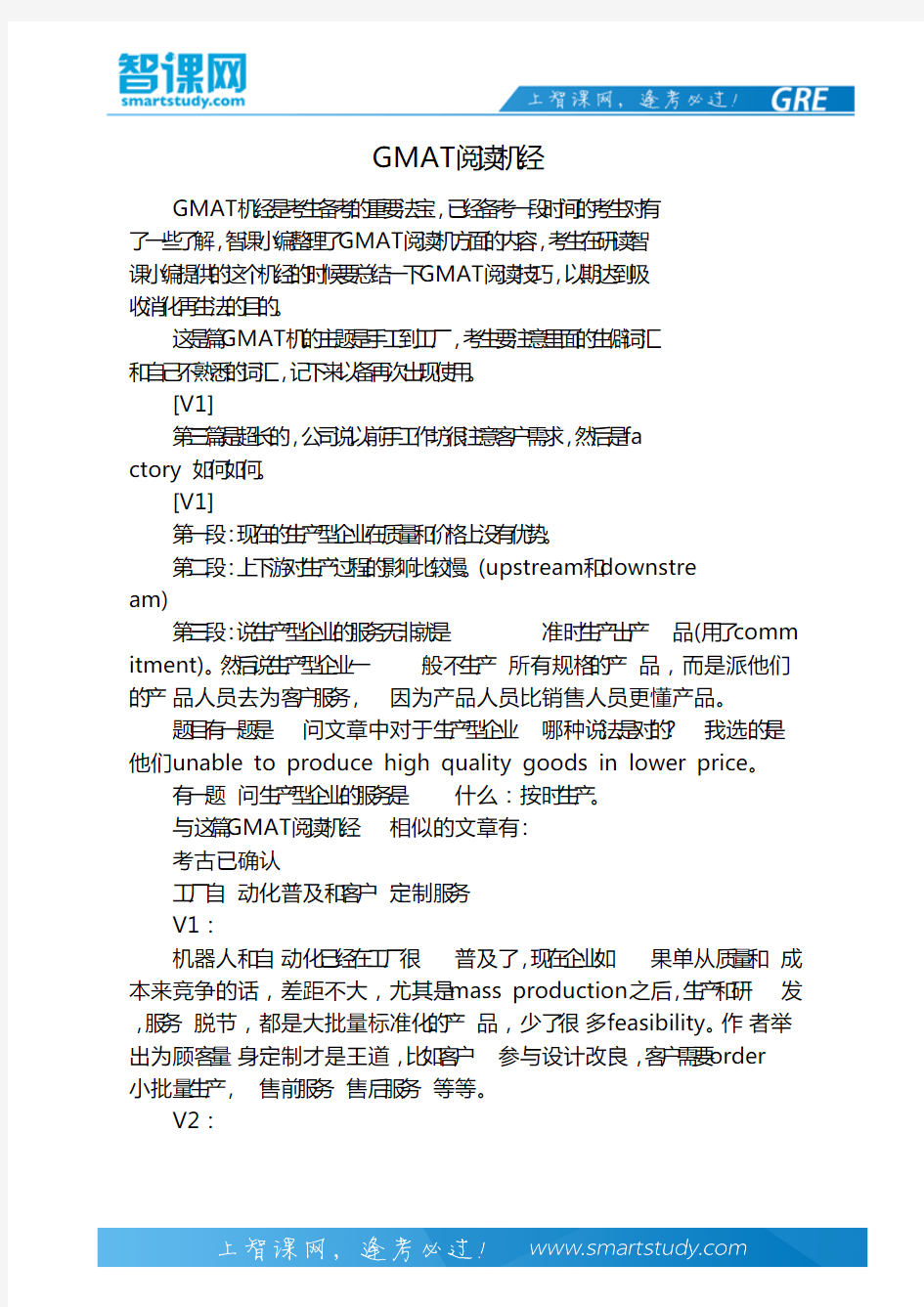GMAT阅读机经


智 课 网 G R E 备 考 资 料
GMAT阅读机经
GMAT机经是考生备考的重要法宝,已经备考一段时间的考生对有了一些了解,智课小编整理了GMAT阅读机方面的内容,考生在研读智课小编提供的这个机经的时候要总结一下GMAT阅读技巧,以期达到吸收消化再生法的目的。
这是篇GMAT机的主题是手工到工厂,考生要注意里面的生僻词汇和自己不熟悉的词汇,记下来以备再次出现使用。
[V1]
第三篇是超长的,公司说以前手工作坊很注意客户需求,然后是fa ctory 如何如何。
[V1]
第一段:现在的生产型企业在质量和价格上没有优势。
第二段:上下游对生产过程的影响比较慢。(upstream和downstre am)
第三段:说生产型企业的服务无非就是准时生产出产品(用了comm itment)。然后说生产型企业一般不生产所有规格的产品,而是派他们的产品人员去为客户服务,因为产品人员比销售人员更懂产品。
题目有一题是问文章中对于生产型企业哪种说法是对的?我选的是他们unable to produce high quality goods in lower price。
有一题问生产型企业的服务是什么:按时生产。
与这篇GMAT阅读机经相似的文章有:
考古已确认
工厂自动化普及和客户定制服务
V1:
机器人和自动化已经在工厂很普及了,现在企业如果单从质量和成本来竞争的话,差距不大,尤其是mass production之后,生产和研发,服务脱节,都是大批量标准化的产品,少了很多feasibility。作者举出为顾客量身定制才是王道,比如客户参与设计改良,客户需要order 小批量生产,售前服务售后服务等等。
V2:
第一段:对现状进行分析,提出问题,认为低成本,高质量并不能满足未来客户的需求,而是应该有更好的customer
service。第二段:对比了handmade
craft,对于顾客需求是量身定做。由于后来顾客开始重视mass produc tion,成本和质量成为了主要的侧重点。Manufacture也分成了三个部分,中间的生产环节与upstream和downstream脱节。而且,由于hier archy,与生产并无直接联系的headquarters还经常对生产环节指手画脚。第三段:人们发现了upstream与manufacture的脱节的disadvant ages,并对此进行了一些改进。(无考点)第四段:但人们并没有意识到downstream和manufacture的脱节的disadvantage,作者指出此问题能够如何进行改善。
Q1:(760)主旨题:
介绍现象,提出改进方案
Q2:传统工厂infer以下哪种:
我选traditional factory生产的都是大批量的货品
(对比作者小批量定制的提议)
Q3:一下哪个不是作者提倡的:
选生产只是单纯的meet
deadline,而不考虑客户实际需求。(有原文,简单)
Q4: the definition of service of the traditional industries includes which of the following?
很简单,原文中找,就是那个“commitment of meeting
date”题目中是“meeting deadline”。然后那个原文concern about什么,楼主选的是“recommend a new approach(之类的) Q5: (760)infer题:
manufacture存在很强烈的阶层(hierarchy)Q6:(760)traditional manufacturing means what? Meeting the deadline.Q7:
(760)infer题,选择A,nowadays customers are not so crazy about low cost or high quality.
对于手工与工厂的GMAT阅读文章,大家一定要从这几篇文章中总结一些GMAT阅读技巧,生发出属于自己的GMAT阅读技巧。
说想象过整个工厂都是计算器和机器人在工作吗?事实上现下的工厂完全可以做到这样。只不过因为它们的竞争对手也有这样的技术水准,所以做成这样也没用。现下的企业还是需要特别关心对顾客的服务,包括售前和售后的。从前的手工艺人就是靠细致的服务,从设计到制作到修改,来赢得客户。当大生产开始后,人们放弃了昂贵的手工订做,转向批量制作的商品。设计制作这道工序开始被从销售的前期工作中剥离,它与后期工作即售后服务的关系也不那么紧密了,但是,转变并没有那么剧烈。即使是最道统的工厂也要考虑到顾客的需求,哪怕这样的考虑仅仅是要按时交货(出题)。而工厂里的制作工人往往能对销售人员起非常重要的作用,比如及时提供货品的数据以帮助他们赢得更多的订单(出题),还比如可以向顾客解释产品的特性以及修理产品。
参考文献偏长,貌似不完全是原文,但是重心思想类似,有时间的同学可以看下:
The factory of the future is not a place where computers, robots, and flexible machines do the drudge work. That is the factory of the present, which, with money and brains, any manufacturing business can build. Of course, any competitor can build one too—which is why it is becoming harder and harder to compete on manufacturing excellence alone. Lower costs, higher quality, and greater product variety are like table stakes in poker—the price that companies pay to enter the game. Most products can be quickly and easily imitated; and the most automated design and production processes cannot decisively beat the second most automated. Who wins and who loses will be determined by how companies play, not simply by the product or process technologies that qualify them to compete.
The manufacturers that thrive into the next generation, then, will compete by bundling services with products, anticipating and responding to a truly comprehensive range of customer needs. Moreover, they will make the factory itself the hub of their efforts to get and hold customers—activities that now are located in separate, often distant, parts of the organization.
Production workers and factory managers will be able to forge and sustain new relationships with customers because they will be in direct and continuing contact with them. Manufacturing, in short, will become the cortex of the business. Today’s flexible factories will become tomorrow’s service factories.
???
About 200 years ago, when horse-drawn carriages were made largely by craftsmen, the most successful carriage maker was invariably the most accommodating. Though he prided himself on being a technician—a manufacturer—his success depended heavily on his willingness and ability to talk with customers at key points: before the sale, so he could get a clear idea of what the client needed and what features would satisfy him; during the manufacturing process, so he could incorporate any necessary changes in the product; and after delivery, so he could learn what features had worked (and what hadn’t) and what the client needed for maintenance, repair, and replacement.
Mass production overtook customized craftsmanship because customers came to value standardized goods over higher priced, personalized goods. As a result, work grew increasingly compartmentalized through the division of labor. Craftsmanship (that is, manufacturing) became separated from downstream activities, like sales and postpurchase service, as well as from upstream activities, like new-product development and design. Gradually, manufacturing received more and more of its information and instructions through filters—divisions and departments that were separated, functionally and physically, from the production site. Not surprisingly, manufacturing managers complained that those who defined their work rarely understood it or cared enough about its details, problems, or technical
possibilities.
For decades, companies muddled through. In recent years, as Japanese competition put pressure on manufacturing businesses everywhere, manufacturers have worked mightily and successfully to educate workers and break down some of the barriers between their upstream activities and the work of the factory. They have encouraged interfunctional communication between product designers and manufacturing engineers and between R&D; and quality managers on the factory floor.
These imaginative efforts to accelerate product innovation and improve manufacturing performance were necessary and important. But they are no longer adequate. Today downstream activities have to be joined to the tasks of the factory too. Increasingly, factory personnel have the means to support the sales force, service technicians, and consumers. This support should, and will, be used. Competition is shifting away from how companies build their products to how well they serve customers before and after they build them.
???
Some of America’s best-run companies—Hewlett-Packard, Allen-Bradley, Caterpillar, Frito-Lay—already operate factories whose activities reflect the new role of service in manufacturing competition. None of their facilities is a complete service factory. We are still many years from that. But in the range of upstream and downstream activities these factories perform, and in the degree of interaction between production workers and customers, they point the way to the future.
Service for a manufacturing company inescapably revolves around its products—their design, features, durability, repairability, distribution, and ease of installation and use. Even the most traditional factories of yesterday proffered service of a kind, but their conception of service was narrow. To old-guard factory managers, service was little more than a commitment to
meeting due dates. Logistics and distribution urged the factory
to complete orders in a timely fashion, to give advance notice of delivery problems, and to package materials for ease of shipment and damage control. Customers were simply numbers on a production schedule.
以上就是智课小编辑整理的GMAT机经,这是篇文章讲述了如何解决GMAT阅读中手工与工厂内容的解答思路,同时也提到了熟练解决此类问题的GMAT阅读技巧:熟练掌握关于此内容的词汇。希望智课小编的整理能帮助到考生。
